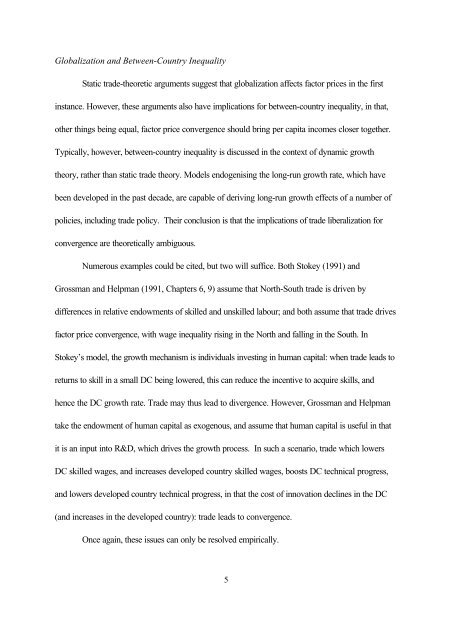Globalization and Inequality - Trinity College Dublin
Globalization and Inequality - Trinity College Dublin
Globalization and Inequality - Trinity College Dublin
Create successful ePaper yourself
Turn your PDF publications into a flip-book with our unique Google optimized e-Paper software.
<strong>Globalization</strong> <strong>and</strong> Between-Country <strong>Inequality</strong><br />
Static trade-theoretic arguments suggest that globalization affects factor prices in the first<br />
instance. However, these arguments also have implications for between-country inequality, in that,<br />
other things being equal, factor price convergence should bring per capita incomes closer together.<br />
Typically, however, between-country inequality is discussed in the context of dynamic growth<br />
theory, rather than static trade theory. Models endogenising the long-run growth rate, which have<br />
been developed in the past decade, are capable of deriving long-run growth effects of a number of<br />
policies, including trade policy. Their conclusion is that the implications of trade liberalization for<br />
convergence are theoretically ambiguous.<br />
Numerous examples could be cited, but two will suffice. Both Stokey (1991) <strong>and</strong><br />
Grossman <strong>and</strong> Helpman (1991, Chapters 6, 9) assume that North-South trade is driven by<br />
differences in relative endowments of skilled <strong>and</strong> unskilled labour; <strong>and</strong> both assume that trade drives<br />
factor price convergence, with wage inequality rising in the North <strong>and</strong> falling in the South. In<br />
Stokey’s model, the growth mechanism is individuals investing in human capital: when trade leads to<br />
returns to skill in a small DC being lowered, this can reduce the incentive to acquire skills, <strong>and</strong><br />
hence the DC growth rate. Trade may thus lead to divergence. However, Grossman <strong>and</strong> Helpman<br />
take the endowment of human capital as exogenous, <strong>and</strong> assume that human capital is useful in that<br />
it is an input into R&D, which drives the growth process. In such a scenario, trade which lowers<br />
DC skilled wages, <strong>and</strong> increases developed country skilled wages, boosts DC technical progress,<br />
<strong>and</strong> lowers developed country technical progress, in that the cost of innovation declines in the DC<br />
(<strong>and</strong> increases in the developed country): trade leads to convergence.<br />
Once again, these issues can only be resolved empirically.<br />
5
















